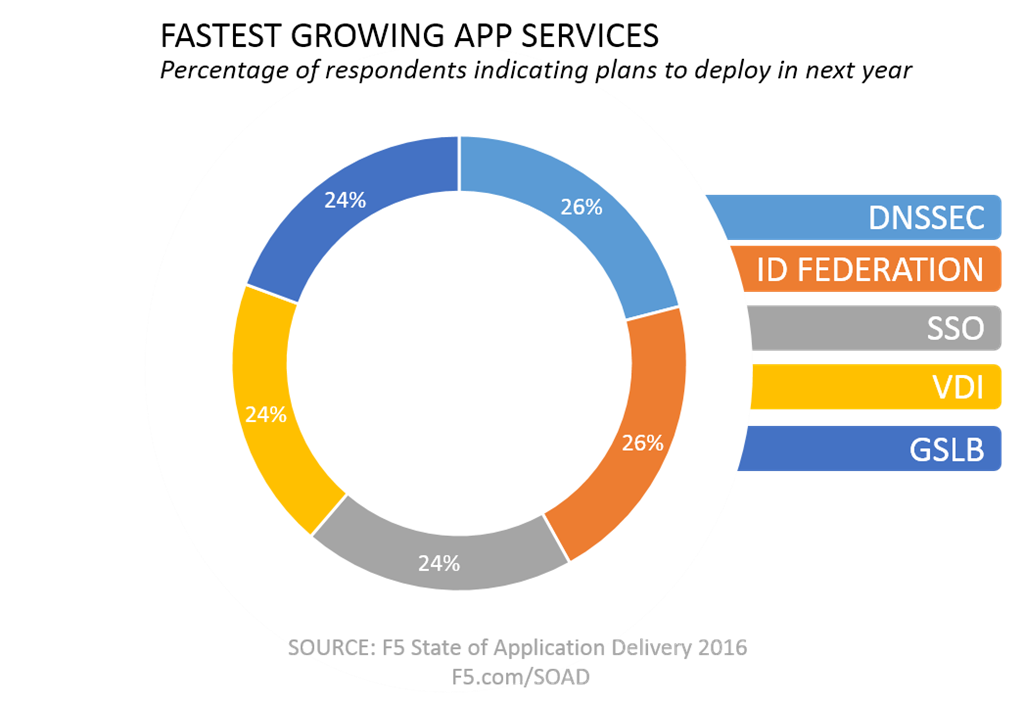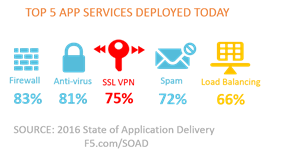Stand der Anwendungsbereitstellung 2016: Die App-Dienste, die jeder nutzt

App-Dienste. Ob wir sie nun SDAS (Software-defined Application Services, Softwaredefinierte Anwendungsdienste) oder einfach gute alte App-Dienste nennen, wir meinen damit praktisch dasselbe: jene Dienste, die zwischen Apps und ihren Benutzern (seien es nun Personen, Dinge oder andere Apps) sitzen und die Sicherheit, Verfügbarkeit und den schnellen Datenaustausch gewährleisten.
Dies sind die „Netzwerkdienste“, die sich auf den Ebenen 4 bis 7 befinden; die zustandsbehafteten Dienste, die in jedem Rechenzentrum vorhanden sind, unabhängig davon, ob sie anerkannt werden oder nicht.
Dies sind die Dienste, die F5 sehr ernst nimmt und die es über seine Hardware-, virtuellen und Cloud-basierten Plattformen bereitzustellen versucht.
Aber das tut nicht jeder. App-Dienste werden häufig als „Lastausgleich, WAN-Optimierung und dergleichen“ beschrieben und erhalten selten die Aufmerksamkeit, die sie verdienen, angesichts ihrer Rolle im kritischen Pfad, der den Benutzern jede Sekunde des Tages Apps liefert. Aus diesem Grund haben wir begonnen, Fragen zu ihnen zu stellen, die sonst niemand stellt. Was verwendest du? Was möchten Sie verwenden? Wo möchten Sie sie einsetzen? Wie möchten Sie sie übermitteln?

Das Ergebnis des letzten Jahres war der erste Bericht zum Stand der Anwendungsbereitstellung, den wir in diesem Jahr gerne weiterverfolgen (und den wir zukünftig jährlich weiterverfolgen möchten). Indem wir uns tiefer mit der Landschaft der Anwendungsdienste befassen, können wir nicht nur Erkenntnisse über die App-Dienste selbst gewinnen, sondern auch über die Pläne und Bedenken von Organisationen auf der ganzen Welt im Hinblick auf neue Architekturen, Ansätze, Technologien und Trends.
Wenn wir uns beispielsweise die am schnellsten wachsenden App-Dienste für 2016 ansehen – also diejenigen, die Unternehmen in diesem Jahr einführen möchten –, sehen wir, dass sich die Unternehmen darauf konzentrieren, Bedenken hinsichtlich der Dominanz der Hybrid Cloud in allen Branchen auszuräumen.
ID Federation (26 %) und SSO (24 %) sowie GSLB (24 %) sind allesamt App-Dienste, die für die Lösung wichtiger Sicherheits- und Produktivitätsbedenken im Zusammenhang mit der Hybrid Cloud sowohl von IT-Experten in der Führungsebene als auch an der Front von entscheidender Bedeutung sind. Schließlich ist die Identitätsföderation das wichtigste Mittel zur Gewährleistung der Steuerung von zunehmend geschäftskritischen SaaS-Anwendungen und zur Gewährleistung, dass der Zugriff auf Unternehmensidentitäten und -verantwortlichkeiten und nicht auf der Grundlage von Benutzeridentitäten und -verantwortlichkeiten erfolgt. Und auch SSO (Single-Sign-On) spielt eine wichtige Rolle, wenn es darum geht sicherzustellen, dass über mehrere Umgebungen verteilte Anwendungen (Hybrid-Cloud) die Produktivität von Unternehmensbenutzern nicht dadurch beeinträchtigen, dass sie Einschränkungen im Zusammenhang mit der Verwaltung (und dem Merken) von fünfzehn verschiedenen Passwörtern auferlegen.

Sogar die Daten zur aktuellen Landschaft zeigen uns, worauf sich CIOs und Unternehmen konzentrieren. Von den derzeit fünf wichtigsten App-Diensten konzentrieren sich vier auf die Sicherheit: Sicherheit des Netzwerks, der Kommunikation und der Daten. Der fünfte? Lastausgleich (Verfügbarkeit) natürlich. Denn Sicherheit ohne Maßstab ist wie ein Klavier ohne Tasten.
Sie haben diesen Vergleich noch nie gehört, oder?
Und genauso wie wir aus den heute eingesetzten App-Diensten Rückschlüsse auf Trends, Technologien und Anliegen ziehen können, können wir auch verstehen, warum so viele Rollen in den IT-Silos von Organisationen so viel Wert auf Funktionen wie APIs und intelligente Vorlagen legen. Es zeigt sich, dass in einem durchschnittlichen Unternehmen derzeit elf verschiedene App-Dienste im Einsatz sind, von denen viele miteinander verkettet sind, um jede einzelne Anwendung bereitzustellen, zu sichern und zu optimieren. Die Mehrheit der Organisationen nutzt zehn oder mehr der vierundzwanzig von uns abgefragten Dienste. Und nicht unerhebliche 30 % nutzen alle verfügbaren Dienste, um Sicherheit, Verfügbarkeit, Mobilität, Leistung und Zugriffskontrolle für Anwendungen in ihrem Rechenzentrum zu gewährleisten. Bei denen, die das nicht tun, könnte es nächstes Jahr soweit sein, denn 25 % planen, im Jahr 2016 vier oder mehr Sicherheitsdienste einzusetzen, und 55 % geben an, dass sie mindestens einen Verfügbarkeitsdienst einsetzen werden.
Der Abschluss? Alle App-Dienste – nicht nur die drei, die bei L4-7 nachträglich erwähnt werden – werden von Organisationen eingesetzt, um für Anwendungen und das Geschäft entscheidende Funktionen bereitzustellen.
Ihre Bedeutung lässt sich wahrscheinlich am besten im Kontext einer meiner Lieblingsfragen der Umfrage verstehen, die sich auf die Frage konzentriert, worauf die Befragten verzichten würden, wenn ihre Netzwerke dadurch sicherer würden. Angesichts der Anzahl spektakulärer Sicherheitsverletzungen im vergangenen Jahr (ganz zu schweigen von den vergangenen zehn Jahren) und der erheblichen negativen Auswirkungen, die diese Sicherheitsverletzungen auf den Ruf und die Geschäftsfähigkeit von Unternehmen hatten, müssten Unternehmen den Wert dieser Dienste schon sehr hoch einschätzen, um sagen zu können: „Nein, darauf werde ich nicht verzichten, auch wenn mein Netzwerk dadurch sicherer wird.“
Welche Dienste waren also so wichtig?
Lediglich 7 % würden auf die Verfügbarkeit verzichten. Nur 10 % würden auf Leistung verzichten. Ein Viertel (25 %) würde statt dieser beiden App-Dienste lieber auf die Verwaltbarkeit der Infrastruktur verzichten.
Das sagt etwas darüber aus, wie wichtig sie nicht nur für die Bereitstellung von Apps sind, sondern auch für den Erfolg und die Sicherheit dieser Apps für das Unternehmen, das auf sie angewiesen ist.
Weitere Einzelheiten zu App-Diensten sowie Cloud, Sicherheit und SDN/Devops finden Sie im vollständigen Bericht hier unter f5.com/SOAD.
